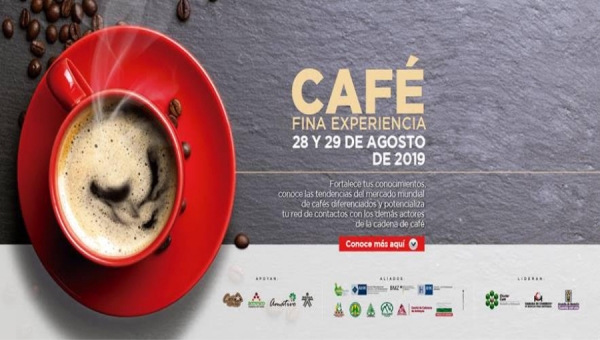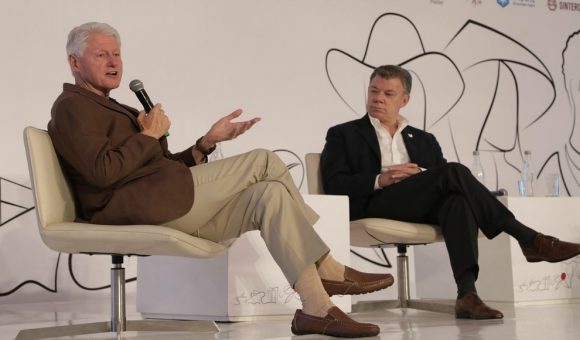Antioquian Coffee Industry Joins Booming Specialty-Coffees Initiative

Antioquian coffee growers, marketers, cooperatives, trade associations, educators, governments and the Medellin Chamber of Commerce for Antioquia (“CCMA” in Spanish initials) are brewing-up a remarkable initiative that aims to percolate a more-profitable “specialty coffee” business — both locally and world-wide.
At the third “Café Fina Experiencia” conference August 28-29 at CCMA-Poblado here in Medellin, more than 300 attendees — including coffee growers, processors, marketers, cooperatives, researchers, roasters, consultants, exporters, importers and international experts — delved into the challenges and opportunities in specialty coffees.
That’s about triple the number of attendees to the first edition of “Café Fina Experiencia” — an encouraging sign, indicating a potentially brighter future for an emerging class of more-sophisticated, more-entrepreneurial growers and marketers.
Given the tremendous growth of “Café Fina Experiencia,” 500 or more attendees probably will participate in the next edition, as “Café Don Tulio” owner Juan Leonardo Garzon Restrepo predicted in closing remarks here.
Numerous experts here cited a dead-end ahead for those producing “commodity coffees” that generate only about US$1 per pound (often less) for the “commodity” grower – or less-than half of today’s actual cost of production here in Colombia.
On the other hand, the specialty coffee market by some estimates is on pace to hit nearly US$40 billion/year globally, with the U.S. and Europe accounting for the bulk of that, as San Francisco-based coffee roaster specialist Floy Andrews of Bay Area Co-Roasters explained here. A recent analysis by Dallas-based Adroit Market Research added that the global specialty coffee business likely would hit more than US$83 biliion by 2025, up from an estimated US$36 billion in 2018.
Meanwhile in Germany, 900 local roaster operations and 72,000 specialty coffee shops have sprung-up around the country – and 82% of those shops are independent rather than chain outlets (such as Starbucks or Peets), as Ally Coffee market representative Nicole Pilz explained here.
The challenge is for Colombia’s specialty coffee growers to get a bigger, sustainable share of those dollars. “People will pay for quality and brand and fair trade – but it’s very difficult to know how much is paid to the farmer,” Andrews pointed-out here.
‘Circular Integration’
What local coffee growers need to create is what Selvadentro coffee consultant Arturo Arevalo termed here as “circular integration” – that is, cooperative alliances between specialty coffee growers, buyers, marketers, exporters, importers, roasters and retailers.
Such “circular integration” potentially could enable local growers stand-up to the “big five” global coffee traders who have gradually developed “vertical integration” – including strict cost and price controls from farming to processing to transport to roasting to retailing.
Today, it’s not enough to put “organic” or “rainforest” or “French roast” or “dark roast” or “mild” or country-of-origin labels on packaged coffees — and then expect to see profits pour-in to coffee growers, who usually get the smallest portion of each dollar spent on a cup of coffee, as experts explained here.
Even the traditional “Juan Valdez” marketing image created over decades to promote Colombian coffee by itself isn’t delivering enough extra margin today to ensure the survival of “commodity” Colombia coffee farmers, according to the experts.
However, many more consumers — especially in Europe, Japan, North America, and even in China — increasingly are becoming aware of the many different flavors of different specialty coffees, which result from different types of coffee beans, different types of processing and different types of roasting, as experts explained here.
In addition, more younger-generation consumers are starting to demand to know what price is being paid to the coffee grower, as Ally Coffee’s Pilz explained in a presentation here.
While traditional coffee-grower trade associations continue to lobby major retail marketers and giant international coffee buyers to pay higher, “fair trade” prices for all coffees (with insufficient results to date), there’s another pathway out of the “commodity-coffee” dead-end: convert more production to higher-margin, better-defined, better-branded specialty coffees, according to experts here.
That’s why CCMA and the “Coffee Cluster” of Antioquia are in the process of developing an initiative that ultimately aims to launch specifically recognized Antioquian specialty coffee brands — along with new marketing opportunities — for potentially thousands of formerly “traditional” coffee growers.
Too many smaller coffee growers today are stuck in the “commodity” coffee cycle, producing perhaps only one or two varieties at too-cheap prices, according to experts.
On the other hand, some more-sophisticated Antioquian growers already produce more than a dozen specialty varieties, including (for example) the ultra-high-margin, but relatively low-volume “Geisha” variety.
What’s more, some of these advanced growers are combining specialty coffee production and marketing with eco-tourism, as for example “La Virgen de Oro” (near Tamesis, Antioquia); “Café Don Tulio” (near Ciudad Bolivar, Antioquia); “La Palma y El Tucan” (in Cundinamarca); “Hacienda La Pradera” (in Santander); and the new “Red Ecolsierra” farm-and-ecotourism network (in the mountains above Santa Marta).
Bird Tourism Pairs With Specialty Coffee
“La Virgin de Oro” owner Jorge Mario Correa told Medellin Herald that besides the 16 specialty coffee varieties he’s producing and marketing, he’s now seeing ever-more growth in bird eco-tourism at his novel eco-farm, which attracts the threatened Cerulean Warbler (Setophaga cerulea)– along with dozens of other species — during the spectacular northern boreal migratory season to Colombia (October to April).
However, not every coffee farm should be considered suitable for eco-tourism, as upscale hotel infrastructure investment can be prohibitive for many farmers, as experts explained here.
Nor would it be wise for every farm to abandon production immediately of all “traditional” coffee and attempt a wholesale switch to exclusive production of certain higher-margin specialty varieties, experts warned. Not only would such a switch take years until first harvest (and first revenues), but also future margins on certain “trendy” varieties could be unpredictable — and might not pay-off the original investment.
However, the new Antioquian specialty-coffees education, branding and marketing initiative spearheaded by the Coffee Cluster aims to help more traditional coffee farmers gradually dedicate more production to specialty coffees — in order to boost profitability and sustainability, while also including dependable buyers.
While the Antioquia specialty coffee initiative is gaining steam, remaining challenges can include recruiting more specialty coffee retailers in higher-margin export markets, as Jerico, Antioquia coffee grower Sandra Castaño explained to Medellin Herald.
One successful example Castaño cited is the “Devocion” Colombian specialty coffee retailer in Brooklyn, New York, founded by Medellin native Steven Sutton.
Another challenge: developing the next generation of Antioquia specialty coffee growers, which explains the emergence of the “PEC” (Programa Educativa del Café) initiative, first organized in 2018 by CCMA along with the Café Cluster, Comfama, SENA, the Antioquian Coffee Committee (Comite Cafetera de Antioquia), the Laboratorio de Cafe and others.
As “PEC” program coordinator Liceth Meneses (CCMA) explained to Medellin Herald, the program aims to help the next generation of Antioquian coffee farmers learn about specialty varieties, as well as help them improve their entrepreneurial and technological skills — which will include environmental sustainability methods.
On a parallel front, too many Antioquia coffee producers still have much to learn about boosting productivity, as “Solidaridad Network” consultant Carlos Isaza explained in a presentation here.
While labor represents more than 70% of the operating cost of coffee farming, just having cheaper labor — as in Nicaragua, where coffee-farm day-labor is about one-third the cost of Colombian day-labor – doesn’t guarantee success, he showed.
Ironically, coffee farming is drastically declining in many cheap-labor Central American countries — except for Costa Rica and Panama, where specialty coffee production and marketing rather than cheap labor has become a salvation for many farmers, he pointed out.
20 Antioquian Coffee Varieties
For the “Café Fina Experiencia” conferences, CCMA so far has catalogued some 20 different varieties of coffee produced in Antioquia, including Borbon, Castilla, Caturra, Variedad Colombia, Pajarito, Chiruso, Cenicafe1, Geisha, Matra Gojo, Catimor, Moka, Sudan Rume, Typica, Margogipe, Java, Arabica, Wush Wush, Catuai, Sl28 and Variedad 2000.
While most coffee farmers might produce only one variety, Medellin’s remaining rural districts still host more than 520 coffee producers, as Medellin’s secretary of economic develop Paula Andrea Zapata Galeano pointed out in a presentation here.
What’s more, another 93,000 coffee farms continue to operate in other areas of Antioquia, producing about 1.5 million bags (154 pounds per bag) per year.
Now, the challenge for many of these traditional farmers is how to convert to specialty coffee production — and climb aboard a “circular integration” train to higher profitability.
















